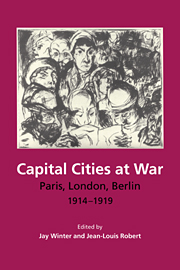Book contents
- Frontmatter
- Contents
- Note on joint authorship
- List of figures
- List of tables
- Part 1 Premises
- Part 2 The Social Relations of Sacrifice
- Part 3 The social relations of labour
- Part 4 The social relations of incomes
- Part 5 The social relations of consumption
- 11 Feeding the cities
- 12 Coal and the metropolis
- 13 Housing
- Part 6 Urban demography in wartime
- Part 7 Towards a social history of capital cities at war
- Statistical appendix and tables
- Bibliography
- Index
13 - Housing
Published online by Cambridge University Press: 15 December 2009
- Frontmatter
- Contents
- Note on joint authorship
- List of figures
- List of tables
- Part 1 Premises
- Part 2 The Social Relations of Sacrifice
- Part 3 The social relations of labour
- Part 4 The social relations of incomes
- Part 5 The social relations of consumption
- 11 Feeding the cities
- 12 Coal and the metropolis
- 13 Housing
- Part 6 Urban demography in wartime
- Part 7 Towards a social history of capital cities at war
- Statistical appendix and tables
- Bibliography
- Index
Summary
For the urban historian, 1914 marks the end of a cycle in urban growth that saw the convergence of patterns of living space in the great European cities. Despite differences in building design and style – London with its individual houses, Paris and Berlin with their blocks of flats or Mietskaserne – the three capitals had many similarities. The trend since the end of the nineteenth century had been to move residential areas to the outskirts, away from the administrative city centre. Living standards had risen as houses acquired amenities now taken for granted (main drainage, water, and gas), though social inequalities persisted. Housing patterns reflected these inequalities: renting remained the norm, though ownership, together with the tendency to live further out from the city centre, already was spreading beyond the most prosperous. This parallelism in pre-war trends helps account for the similar impact of the war on housing in all three cities. The war's effects differed in intensity, not in kind.
With the outbreak of war, residents of the three cities faced familiar problems in a new guise. Mobilization or unemployment meant difficulty in paying rent for those with reduced or non-existent resources; and low-cost housing was in short supply, either because of demand as inhabitants moved from one sector of the market to another, or because of the large influx of immigrants. Those who suffered most were the socially deprived, the poorest, the least favoured in life. Some social divisions were blurred.
- Type
- Chapter
- Information
- Capital Cities at WarParis, London, Berlin 1914–1919, pp. 374 - 418Publisher: Cambridge University PressPrint publication year: 1997
- 2
- Cited by

